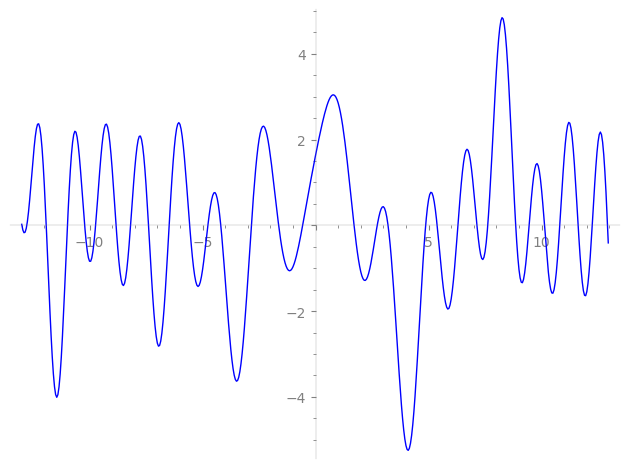| L(s) = 1 | + (1.5 − 2.59i)5-s + (0.5 − 2.59i)7-s + (−0.5 − 0.866i)11-s − 4·13-s + (2 + 3.46i)17-s + (4 − 6.92i)23-s + (−2 − 3.46i)25-s + 7·29-s + (−5.5 − 9.52i)31-s + (−6 − 5.19i)35-s + (−2 + 3.46i)37-s + 4·41-s − 2·43-s + (−1 + 1.73i)47-s + (−6.5 − 2.59i)49-s + ⋯ |
| L(s) = 1 | + (0.670 − 1.16i)5-s + (0.188 − 0.981i)7-s + (−0.150 − 0.261i)11-s − 1.10·13-s + (0.485 + 0.840i)17-s + (0.834 − 1.44i)23-s + (−0.400 − 0.692i)25-s + 1.29·29-s + (−0.987 − 1.71i)31-s + (−1.01 − 0.878i)35-s + (−0.328 + 0.569i)37-s + 0.624·41-s − 0.304·43-s + (−0.145 + 0.252i)47-s + (−0.928 − 0.371i)49-s + ⋯ |
\[\begin{aligned}\Lambda(s)=\mathstrut & 2016 ^{s/2} \, \Gamma_{\C}(s) \, L(s)\cr =\mathstrut & (-0.605 + 0.795i)\, \overline{\Lambda}(2-s) \end{aligned}\]
\[\begin{aligned}\Lambda(s)=\mathstrut & 2016 ^{s/2} \, \Gamma_{\C}(s+1/2) \, L(s)\cr =\mathstrut & (-0.605 + 0.795i)\, \overline{\Lambda}(1-s) \end{aligned}\]
Particular Values
| \(L(1)\) |
\(\approx\) |
\(1.635488399\) |
| \(L(\frac12)\) |
\(\approx\) |
\(1.635488399\) |
| \(L(\frac{3}{2})\) |
|
not available |
| \(L(1)\) |
|
not available |
\(L(s) = \displaystyle \prod_{p} F_p(p^{-s})^{-1} \)
| $p$ | $F_p(T)$ |
|---|
| bad | 2 | \( 1 \) |
| 3 | \( 1 \) |
| 7 | \( 1 + (-0.5 + 2.59i)T \) |
| good | 5 | \( 1 + (-1.5 + 2.59i)T + (-2.5 - 4.33i)T^{2} \) |
| 11 | \( 1 + (0.5 + 0.866i)T + (-5.5 + 9.52i)T^{2} \) |
| 13 | \( 1 + 4T + 13T^{2} \) |
| 17 | \( 1 + (-2 - 3.46i)T + (-8.5 + 14.7i)T^{2} \) |
| 19 | \( 1 + (-9.5 - 16.4i)T^{2} \) |
| 23 | \( 1 + (-4 + 6.92i)T + (-11.5 - 19.9i)T^{2} \) |
| 29 | \( 1 - 7T + 29T^{2} \) |
| 31 | \( 1 + (5.5 + 9.52i)T + (-15.5 + 26.8i)T^{2} \) |
| 37 | \( 1 + (2 - 3.46i)T + (-18.5 - 32.0i)T^{2} \) |
| 41 | \( 1 - 4T + 41T^{2} \) |
| 43 | \( 1 + 2T + 43T^{2} \) |
| 47 | \( 1 + (1 - 1.73i)T + (-23.5 - 40.7i)T^{2} \) |
| 53 | \( 1 + (5.5 + 9.52i)T + (-26.5 + 45.8i)T^{2} \) |
| 59 | \( 1 + (-3.5 - 6.06i)T + (-29.5 + 51.0i)T^{2} \) |
| 61 | \( 1 + (5 - 8.66i)T + (-30.5 - 52.8i)T^{2} \) |
| 67 | \( 1 + (5 + 8.66i)T + (-33.5 + 58.0i)T^{2} \) |
| 71 | \( 1 + 6T + 71T^{2} \) |
| 73 | \( 1 + (-3 - 5.19i)T + (-36.5 + 63.2i)T^{2} \) |
| 79 | \( 1 + (5.5 - 9.52i)T + (-39.5 - 68.4i)T^{2} \) |
| 83 | \( 1 + 11T + 83T^{2} \) |
| 89 | \( 1 + (-3 + 5.19i)T + (-44.5 - 77.0i)T^{2} \) |
| 97 | \( 1 - 7T + 97T^{2} \) |
| show more | |
| show less | |
\(L(s) = \displaystyle\prod_p \ \prod_{j=1}^{2} (1 - \alpha_{j,p}\, p^{-s})^{-1}\)
Imaginary part of the first few zeros on the critical line
−8.825790505456950115006492079970, −8.184734481214841461052005947870, −7.39089583952878073543513655830, −6.47802843432224719329602067326, −5.57028933533279822657902450197, −4.76355513577118630879311214882, −4.19387527583741311891579361334, −2.83992034528009289727692786305, −1.63272246186770323194874655328, −0.57146776508138604861323864386,
1.70348918249731420977608243978, 2.72796646846321541373372023178, 3.20629836787024761880809444655, 4.87084254526608595186970851402, 5.37817082947742732822112948661, 6.29798030149334264566211691806, 7.14018844687413372843643723201, 7.61734822815250132847842607840, 8.854755431610770690849582636258, 9.448672979203630271741082129894

